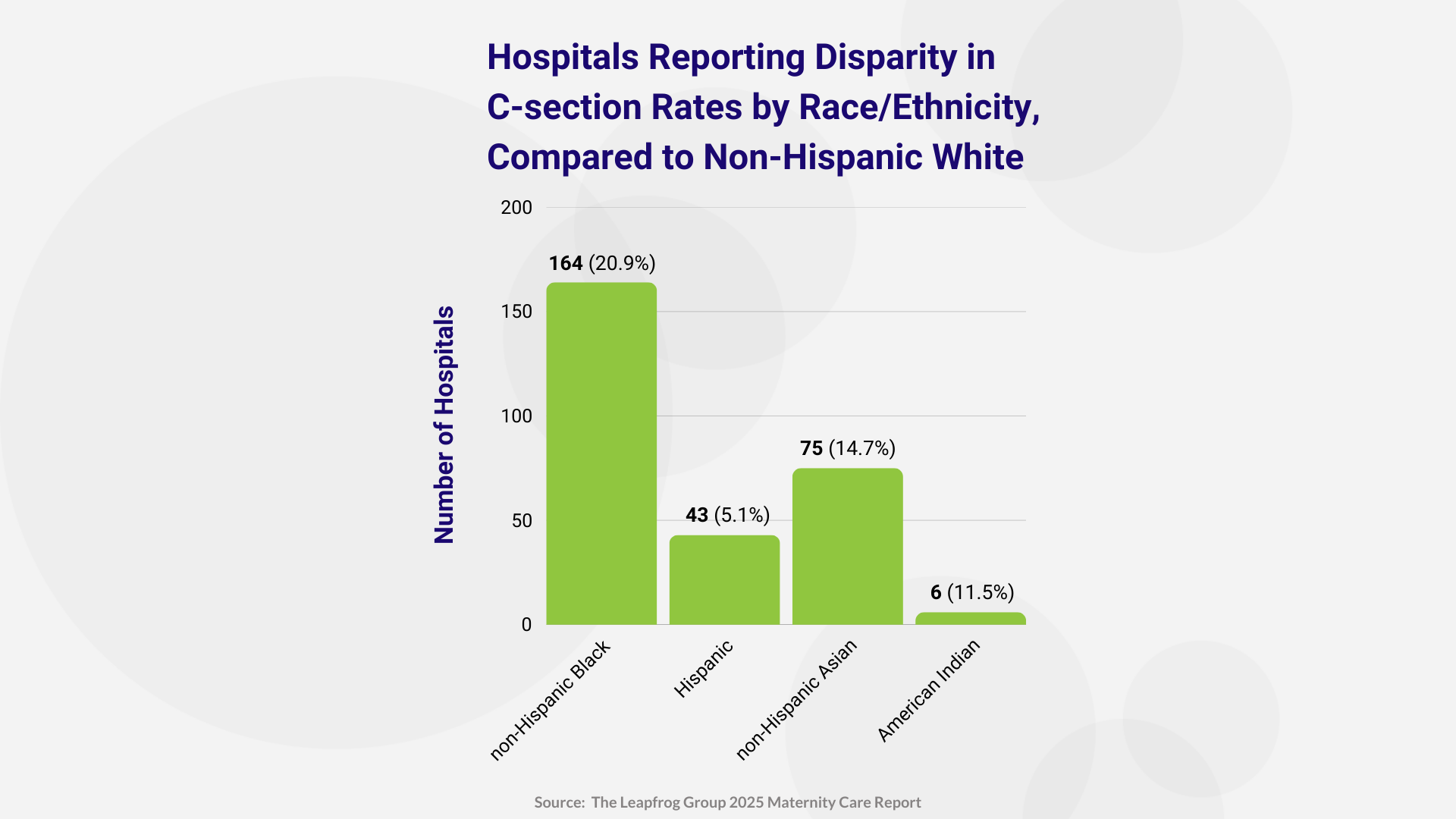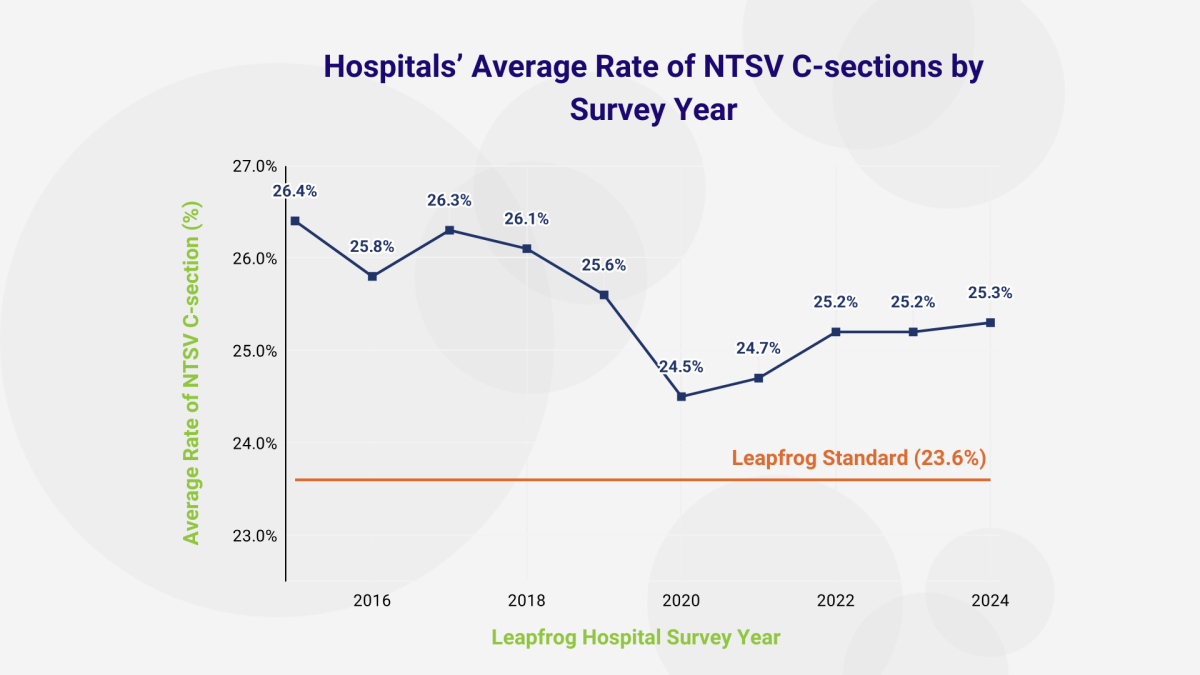
April is C-Section Awareness Month, a time to reflect on the rates of cesarean sections (C-sections) and the need for better maternity care practices. C-sections are life-saving when medically necessary, but they come with significant risks for both mothers and babies. With nearly one-third of births in the U.S. delivered by C-section, it’s more important than ever to focus on reducing unnecessary procedures and ensuring safer, more equitable care for all.
Leapfrog's 2025 Maternity Care Report shines a spotlight on the state of cesarean births in hospitals across the country. The report highlights stagnation in reducing unnecessary C-section rates, as well as racial/ethnic disparities. As we observe C-Section Awareness Month, we take a closer look at the report’s findings and what they mean for expectant families and health care providers.
C-section Rates for Low-Risk, First-Time Mothers Is Not Improving
C-sections are essential in certain situations, but they are overused in many cases. Leapfrog’s report reveals that, despite efforts to reduce unnecessary C-sections, the national NTSV (Nulliparous, Term, Singleton, Vertex) C-section rate has only improved slightly in recent years. In 2015, the national average for NTSV C-sections was 26.4%, and it has decreased modestly to 25.3% in 2024. Although this is progress, it is slower than expected, and many hospitals still struggle to meet the Leapfrog Standard of a 23.6% NTSV C-section rate.
This slow progress is particularly concerning in the years following the COVID-19 pandemic. The continued overuse of C-sections, particularly among low-risk first-time mothers, increases the risk of serious complications. For mothers, these include infections, blood clots and longer recovery times. For babies, the risks are just as significant. C-sections can lead to breathing difficulties for newborns, which increases the likelihood of NICU admissions. These risks could often be avoided with more careful and selective use of C-sections, as well as with more support for vaginal birth after cesarean (VBAC) and other alternatives to surgical delivery.
Racial and Ethnic Disparities Found in C-section Rates
With guidance from our Maternity Care Expert Panel, Leapfrog aims to help hospitals identify disparities within their own patient populations. The data gives hospitals important insights to address disparities and recognize patterns in care delivery that need improvement. One of the most troubling findings from the report is the ongoing disparities in C-section rates between racial and ethnic groups. Non-Hispanic Black patients are more likely to undergo a C-section compared to non-Hispanic White patients, with one in five hospitals reporting this disparity.
This points to deeper systemic issues in maternity care that need to be addressed. Hospitals must work to understand the causes of these differences and take steps to ensure that all patients receive the best possible care. Reducing disparities is crucial to improving health outcomes for all mothers and babies.

How You Can Help
Patients, families, advocates, employers, policymakers and hospitals all play an important role in promoting safer maternity care. Here's how you can get involved:
- Stay informed: Learn about your hospital's C-section rates and the practices they follow. Ask about their policies regarding VBAC attempts and early elective deliveries.
- Ask questions: Ask about delivery options. Understand the risks and benefits of both cesarean and vaginal births, and make sure your health care team is committed to providing evidence-based care.
- Advocate for change: Encourage hospitals in your community to prioritize reducing unnecessary C-sections and addressing disparities in maternity care. Encourage your hospital to participate in the Leapfrog Hospital Survey and to use Leapfrog's resources.
- Support awareness campaigns: Share information about C-section Awareness Month with your community. Raising awareness about the risks of unnecessary C-sections and the importance of reducing them can help inspire change.
For additional resources and how to use this information, visit the report web page.
Working Toward Better Maternity Care
C-section Awareness Month is a crucial time to reflect on the state of maternity care in the U.S. While cesarean deliveries are necessary in certain cases, the rising rates and disparities in care require our attention. By focusing on reducing unnecessary C-sections we can ensure safer outcomes for both mothers and babies.
Let’s use this month to take action, raise awareness and advocate for better maternity care. Together, we can work to reduce unnecessary C-sections and improve the quality of care for all.
Download the full 2025 Leapfrog Maternity Care Report, view additional resources and explore state-specific data here.
Resources
C-section Basics, National Partnerships for Women & Families
Reducing NTSV C-section Birth, Institute for Perinatal Quality Improvement
Safe Reduction of C-section Births, Alliance for Innovation on Maternal Health
Leapfrog Case Studies
How the Leapfrog Hospital Survey Helped Virginia Hospital Center Lower Its NTSV C-Section Rate, An interview with Virginia Hospital Center
Using Transparency to Spark Improvements in C-Section and Episiotomy Rates, An interview with Holy Name Medical Center

